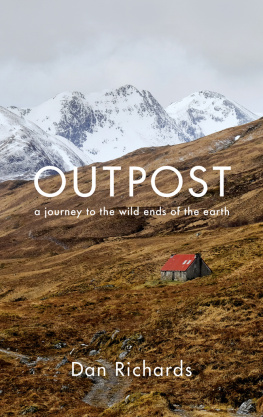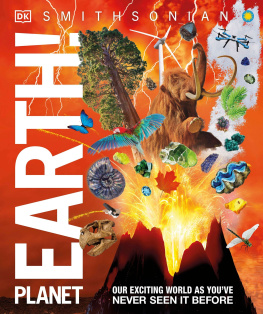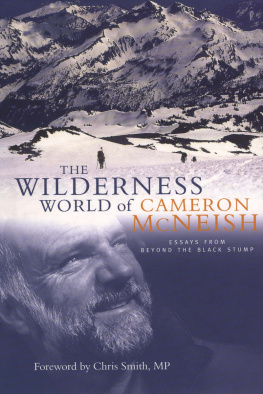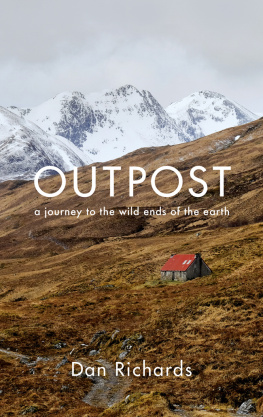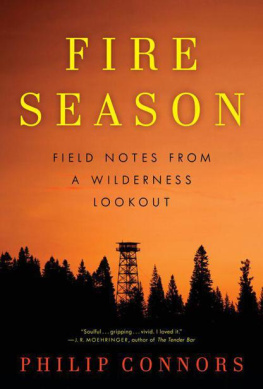OUTPOST
Also by Dan Richards
Holloway (with Robert Macfarlane and Stanley Donwood)
The Beechwood Airship Interviews
Climbing Days
OUTPOST
a journey to the wild ends of the earth
Dan Richards

First published in Great Britain, the USA and Canada in 2019
by Canongate Books Ltd,
14 High Street, Edinburgh EH1 1TE
Distributed in the USA by Publishers Group West and in Canada by Publishers Group Canada
canongate.co.uk
This digital edition first published in 2019 by Canongate Books
Copyright Dan Richards, 2019
The moral right of the author has been asserted
While every effort has been made to trace the owners of copyright material reproduced herein, the publishers would like to apologise for any omissions and will be pleased to incorporate missing acknowledgments in any further editions
For permission credits please see p.305
British Library Cataloguing-in-Publication Data
A catalogue record for this book is available on request from the British Library
ISBN 978 1 78689 155 6
eISBN 978 1 78689 156 3
Typeset in Garamond by Biblichor Ltd, Edinburgh
For David
CONTENTS
The Peace of Wild Things
When despair for the world grows in me
and I wake in the night at the least sound
in fear of what my life and my childrens lives may be,
I go and lie down where the wood drake
rests in his beauty on the water, and the great heron feeds.
I come into the peace of wild things
who do not tax their lives with forethought
of grief. I come into the presence of still water.
And I feel above me the day-blind stars
waiting with their light. For a time
I rest in the grace of the world, and am free.
Wendell Berry
I
HOTEL CALIFORNIA, NY-LESUND

Hotel California, Ny-lesund, Svalbard, 1982. Photograph: Tim Richards
Dear Dan Richards,
your travels will not be easy, but I think you have a fascinating project in the making... I wish you all the best, in particular in the Svalbard archipelago.
Best,
Werner Herzog
I grew up fascinated by the polar bear pelvis in my fathers study.
My mother, Annie, tells me that when my father, Tim, returned from his final Arctic expedition, a month before my birth, it was night and raining hard. From Svalbard hed flown down to Troms, then Luton, caught several trains to reach Swansea and finally a bus to Penclawdd a village on the Gower where my parents lived. Annie had sat by the window all evening, waiting, and now she could see him walking up the shining road, pack on his back. She was listening to Gladys Knight & the Pips, a cassette. Once home he was amazed to see how pregnant Annie was, how round her belly. He was also very taken with the carpet, Annie remembers it felt so good on his tired feet.
Tim had been away for several months on Svalbard a Norwegian archipelago in the Arctic Ocean, situated north of mainland Europe, about halfway between continental Norway and the North Pole exploring the Brgger peninsula and the glaciers, fjords and mountains east of Ny-lesund, the northernmost civilian functional settlement at 78 55' N.
Next morning he unpacked his bag. Everything smelled of smoke. The smell permeated the whole house Trangia smoke and unwashed man and from deep in the stuffed mix of wool and down he drew out the pelvis, abstract, sculptural, bleached, and placed it on the table. Strange object from another world.
Years later, he told me that hed found the bony frame on the ice and glaciers of Kongsfjorden although, as time passed, the story changed and hed swapped it for cake and kit with the expedition doctor. The pelvis lived in the study of our various houses throughout my childhood; less trophy, more alien artefact. It looked so pure, supernaturally white. When held it was heavier than one might expect. It enthralled me; an almost feathered line of peaks ran over the sacrum and coccyx, the broken ends of the flaring hips revealed a coral interior. The hollow eyes of the femur cups, the sinuous lines of the iliac crest, its conch shell-like fissures, cracks and apertures all these tactile features thrilled and intrigued. The idea of my father having discovered it on a glacier an impossibly far-flung landscape of mythical beasts caught my imagination. And the names! Ny-lesund: I rolled the word round like a marble in my mouth; Svalbard: it sounded so cold; and Spitsbergen: somehow colder still.

Polar bear pelvis, Bath, 2016. Photograph: Dan Richards
The pelvis was full of story. To hold it was to think of Tim as a young man in that great white silence, imagine polar bears, the life of that particular bear, and feel my horizons expand.
Theres a photograph of Tim on his expedition. In it, he stands with four others outside the front door of a small wooden shed. A sixth, unseen behind the camera, takes the shot. Everyone smiles. Behind and around them stretch moonland cliffs and dunes. On the back of the photograph is written Hotel California, Ny-lesund. Tim, dressed in a wool hat and striped jumper, dark trousers and big boots, stands holding two pans. At his elbow, leant against the shed, is a long black rifle, for bears. Or rather, in case of bears... He was the expedition marksman and took a shooting course before the party left England but never fired a shot, he reassured me.
They never met a bear.
Which is lucky, because Hotel California doesnt look like it would stand up to a bear.a lost shed stumbled into a shot. The idea of six people sleeping inside it seems implausible and rather eccentric. Yet they gave it a name and called it home and there they are, Tims party, stood beaming outside their shed, an incongruous cabin at the top of the world.
What has become of that shed? As time went on it became inseparable from the pelvis in my imagination, part of an Arctic triptych my father, the pelvis, the shed. It stood clear of the mle of his recollections. The anecdotes about his team being buzzed by Ranulph Fienness spotter plane, climbing mountains, an incident with a boat full of advocaat, sleeping out in the midnight sun, keeping watch for bears, receiving a care package from Annie fruitcake and tea wrapped in newspapers posted up to the worlds northernmost post office all these recollections subtly shifted and changed as the years went on but the fact(s) Tim went to Svalbard, stayed in a shed and brought home a polar bear pelvis remained solid.
Id read that in recent years, due to melting permafrost, wooden buildings in the far north have begun to thaw and rot for the first time. Has the shed gone the way of that bear on the ice fallen down, picked apart, disappeared? At some point I decided to go and discover for myself.
During the course of climbing and researching my last book, Climbing Days, I stayed in a number of high mountain huts. Some were new and state of the art, some, like the Bertol Hut above Arolla in Switzerland, had been rebuilt on the site of earlier sheds, and some stood apparently unchanged since my great-great-aunt and uncle, Dorothea and Ivor, were mountaineering in the 1920s and 30s.

